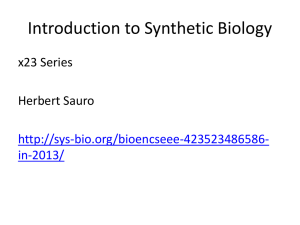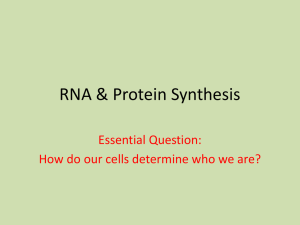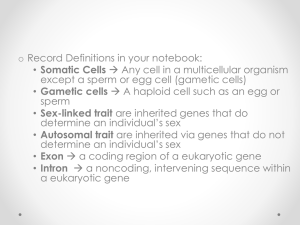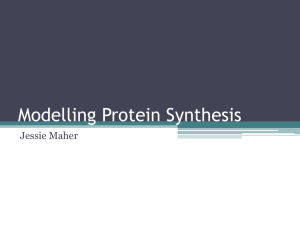Nucleic Acids and Protein Synthesis Modern Biology Chapter 10
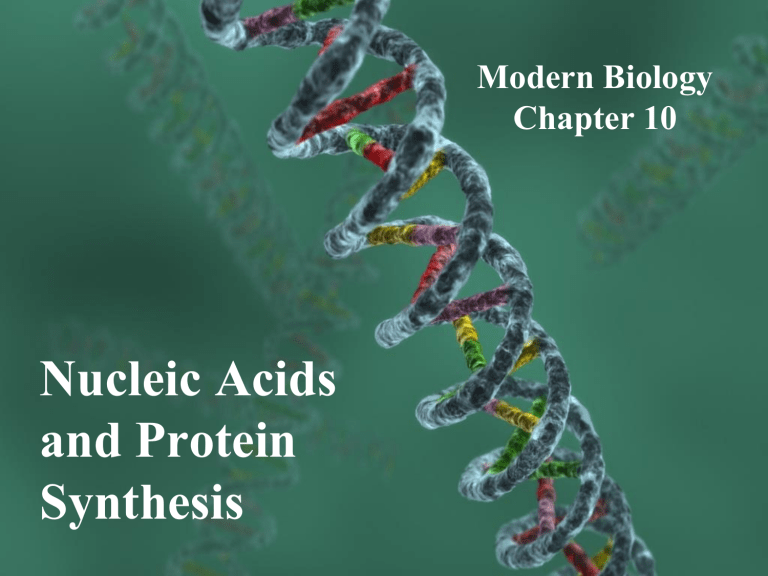
Nucleic Acids and Protein
Synthesis
Modern Biology
Chapter 10
10-1
DNA full name is
DeoxyriboNucleicAcid
A Nucleotide
The monomer of nucleic acids…
Structure of DNA
• Basic Structure
three basic components
deoxyribose: 5 C sugar
Structure of DNA
•
Basic Structure
three basic components
phosphate group (PO
4
) 3-
Structure of DNA
Basic Structure three basic components nitrogenous base adenine (A) guanine (G) thymine (T) cytosine (C)
Structure of DNA
•
The double helix
many scientists worked to solve the structure of
DNA
Chargaff
• Concluded that A must bond with T and C with G
Structure of DNA
•
The double helix
many scientists worked to solve the structure of DNA
Rosalind Franklin
took X-ray photographs of DNA
died in 1958 without recognition for her enormous contribution
X-ray crystallography
Rosiland Franklin
Structure of DNA
•
The double helix
many scientists worked to solve the structure of
DNA
Wilkins
received Nobel prize with Watson and Crick
Structure of DNA
•
The double helix
many scientists worked to solve the structure of
DNA
Watson and Crick
first to construct a model of DNA molecule
received Nobel prize for their work in 1962
Primarily piggy-backed on others’ work, but were the first to put the pieces together correctly
Watson and Crick
Structure of DNA
The double helix
two nucleotide chains that wrap around each other
base-pairs form the rungs of the ladder
Structure of DNA
•
The double helix
alternating chains of phosphate groups and deoxyribose molecules form the backbone of the structure
all rungs are of equal length
approx. 10 base pairs per turn of DNA molecule
Structure of DNA
•
Complementary base pairing
to ensure that the rungs are of equal length nucleic acids pair up
base-pairing rules
cytosine bonds with guanine (C-G)
adenine bonds with thymine (A-T)
Structure of DNA connected by hydrogen bonds
C and G share
3 H-bonds
A and T share
2 H-bonds
Replication of DNA
• replication: process of copying DNA
the steps:
double chains must separate between the nucleic acids
replication fork: point at which the chains separate
helicase: enzyme that breaks apart DNA molecule
nucleotide bases match up with their compliments
DNA polymerase: enzyme that assembles new bases to original strand
Replication of DNA
• replication: process of copying DNA
complimentary bases allow for accurate replication
new strands of DNA actually contain one old strand and one new strand
Types of replication possible with a double strand
•DNA is semiconservative
A movie for your viewing enjoyment
Animation Illustrating DNA Replication by
Complementary Base Pairing
• More complex view
Replication of DNA
•
Accuracy and Repair
highly accurate with only 1 error per 10,000 pairs
mutation: change in a nucleotide sequence
Mutation
Replication of DNA
•
Accuracy and Repair
proofreading and repair reduce error rate to
1 error per 1,000,000,000 base pairings
enzymes proofread and repair any errors that are identified
Equivalent to 1,488,095 copies of Huckleberry
Finn
Fixing the errors
Replication of DNA
•
Accuracy and Repair
some factors increase the rate at which DNA mutates
radiation
certain chemicals
sun light
Radiation
Excited electrons run around uncontrollably and cause problems.
We use this trait for helping patients battle cancer- chemo therapy.
Solar Radiation
RNA
Modern Biology
Chapter 10
Structure of RNA
• full name is RiboNucleic Acid
Structure of RNA basic structure
backbone of phosphate groups and ribose
single stranded
uracil (U) replaces thymine in pairing with adenine
TYPES OF RNA
Types of RNA
• mRNA: messenger RNA
carries copy of DNA strand from nucleus to ribosome
single, uncoiled chain
Types of RNA
• tRNA: transfer RNA
carries specific amino acids to ribosomes to pair with mRNA
single chain (about 80 base pairs long) folded into a hairpin like shape
Types of RNA rRNA: ribosomal RNA
Along with proteins rRNA forms ribosomes
globular form
Transcription
• process where genetic information is copied from DNA to RNA
•
ANIMATION OF THE PROCESS OF
TRANSCRIPTION
Transcription
• steps of transcription
RNA polymerase binds to DNA in specific sites called promoter regions
DNA unzips and nucleic bases follow complementary base-pairing rules
Termination sequence marks end of transcription
• products of transcription are all forms of
RNA
•
Movie Time
• DNA unzips
• RNA polymerase does it’s thing
• RNA is formed
Comparing
DNA and
RNA
Section 12-3
RNA Concept Map
RNA can be
Messenger
RNA
Ribosomal
RNA
Transfer
RNA also called mRNA which functions to
Carry instructions also called rRNA which functions to
Combine with proteins also called tRNA which functions to
Bring amino acids to ribosome from to to make up
DNA Ribosome Ribosomes
Protein structure and composition
• proteins are polymers
• made up of long chains of amino acids
•
20 different amino acids
• proteins fold into specific shapes based on the sequence of amino acids
The amino acids
The genetic code
• genetic code determines sequence of amino acids in proteins nucleolus mRNA
DNA
• genetic code determines sequence of amino acids in proteins
The genetic code
• codon: each triad (group of three bases) on mRNA
each codon codes for a specific amino acid
many codons may code for the same amino acid
start codon (AUG) codes for methionine
stop codons (UAA, UAG, UGA) cause the ribosomes to disengage
Translation
• process of assembling amino acids to form proteins
• tRNA and anticodons
amino acids are transported to ribosomes on tRNAs
tRNAs have anticodons which match up with codons on mRNA
Translation
• ribosomes
site of protein synthesis
three binding sites
mRNA binds to one
two tRNAs with anticodons complementing the codons on mRNA bind to other two
Translation
• protein assembly
ribosome attaches to start codon (AUG)
first amino acid in every polypeptide is methionine
ribosome moves along mRNA matching complementary tRNAs with the amino acids along the way
amino acids form peptide bonds to form polypeptide chains
ribosomes move 3 base pairs at a time (1 codon)
stop codon ends process
Videos
• Raven's
• Test your “mad DNA” skills
Explain this to your neighbor!
Videos
• ANIMATION OF THE PROCESS OF
TRANSLATION
• Animation of Protein Folding
INFORMATION PROCESSING &
THE CENTRAL DOGMA
•the letters of the genetic alphabet are the nucleotides A , T , G , & C
•unit of information is CODON = genetic 'word'
a triplet sequence of nucleotides CAT in a polynucleotide
3 nucleotides = 1 codon (word) = 1 amino acid the definition of (codon) word = amino acid
Size of Human Genome
≈ 3,000,000,000 base pairs or 1.5b in single strand genes
≈ 500,000,000 possible codons (words or amino acids)
Size of Human Genome
to put it in perspective… average page your textbook = approx 850 words thus, the human genome is equal to
590,000 pages or 470 copies of bio text book reading at 3 bases/sec it would take you about
47.6 years @ 8h/d - 7d/w
Size of Human Genome
Mice & humans (indeed, most or all mammals including dogs, cats, rabbits, monkeys, & apes) have roughly the same number of nucleotides in their genomes -- about 3 billion bp.



